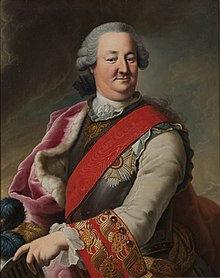Karl August Friedrich (Waldeck-Pyrmont)
Karl August Friedrich zu Waldeck-Pyrmont (born September 24, 1704 in Hanau ; † August 19, 1763 in Arolsen ) was Prince of Waldeck-Pyrmont from 1728 to 1763 . He was also a high-ranking officer in various armies. Most recently he was Commander-in-Chief of the Dutch Army during the War of the Austrian Succession .
origin
His father was Friedrich Anton Ulrich (1676–1728), Count of Waldeck-Pyrmont and first Prince of Waldeck-Pyrmont. The mother was Luise (1678–1753), Countess Palatine von Bischweiler. He came from the Waldeck family .
Life
He was intended for military service from the start. He first served in a French regiment in Alsace and entered Prussian service in 1725 . He temporarily quit military service in 1728 and traveled to Italy, among others. He and his family were enthusiastic about the ancient world and collected old art treasures. After the death of his father and his older brother Christian Philipp, he became Prince of Waldeck.
In the War of the Polish Succession from 1733 to 1738, he served as an imperial sergeant-general. As such, he took part in the 1735 campaign on the Rhine under Eugene of Savoy . At the meeting of Clausen, he distinguished himself. He led his nine companies of grenadiers into battle himself and remained victorious. In 1736 he took part in the campaign to Hungary. In the following years he was involved in the campaigns against the Turks. He was wounded during the siege of the Rissa fortress in 1737 and at Krozka in 1739.
In 1742 Karl August Friedrich was appointed General en Chef of the Dutch Army during the War of the Austrian Succession. There, too, he distinguished himself in several battles. However, the Dutch army was defeated under his command in the battles of Fontenoy , Roucoux and Lauffeldt . The end of his command in the Netherlands began with riots in the Dutch cities as a result of the war loads. For domestic political reasons, Waldeck was replaced by Prince Wilhelm IV of Orange .
In 1746 he was appointed Imperial General Field Marshal. After the death of Count Friedrich zu Sayn-Wittgenstein-Hohenstein , he took over the reign of the County of Sayn-Wittgenstein-Hohenstein for a few years from 1756, because his successor Johann Ludwig (1740-1796) was not yet capable of governing.
Domestically, he tried to limit the debt burden in his small country. However, he and his wife also had the Arolsen Palace redesigned and expanded in keeping with the times in the Rococo style. In 1730 he had the princely hunting lodge Carlsruhe built from Giebringhausen marble in Sudeck . It was demolished in 1790.
Karl issued letters of protection to Jewish people , provided they could prove that they had assets of at least 1,000 thalers. Then the immigration of Jewish residents into the principality began.
During the Seven Years' War the country of Waldeck suffered from marches and battles. The castle Waldeck , lay in a French crew, was two years besieged and bombarded 1,762th
family
In 1741 in Zweibrücken he married Countess Palatine Christiane von Birkenfeld (1725–1816), daughter of Christian III. The couple had the following seven children:
- Karl (1742–1756)
- Friedrich Karl August (1743–1812), successor to his father
- Christian (1744–1798), Field Marshal in the Portuguese Army
- Georg (1747–1813), Prince of Waldeck-Pyrmont and Prince of Pyrmont-Rappoltstein
- Karoline Louise (1748–1782) ⚭ 1765 (divorced 1772) Duke Peter von Biron (1724–1800)
- Luise (1751–1816) ⚭ 1775 Duke Friedrich August von Nassau-Usingen (1738–1816)
- Ludwig (1752–1793), Major General of the Dutch Cavalry, died on June 11, 1793 in battle near Werwick
literature
- Genealogical realm and state handbook for the year 1802 , part 1, p. 249. Digitized descendants.
- L. Curtze: History and description of the principality of Waldeck . Arolsen, 1850 p. 617 f.
- Constantin von Wurzbach : Waldeck, Karl August Friedrich Prince . In: Biographisches Lexikon des Kaiserthums Oesterreich . 52nd part. Imperial-Royal Court and State Printing House, Vienna 1885, p. 174 f. ( Digitized version ).
Web links
Individual evidence
- ↑ Ancient Life: Simulation of an Ideal
- ^ Gerhard Menk : The relationship between Waldeck-Pyrmont and the Netherlands in the modern age. In: Horst Lademacher (Ed.): Oranien-Nassau, the Netherlands and the Reich. Münster, Hamburg, 1995 p. 242 f.
- ↑ Johann Friedrich Blumenbach: Reise ins Waldeckische , 1777, viewed on November 15, 2010 ( Memento of the original from April 16, 2014 in the Internet Archive ) Info: The archive link was inserted automatically and has not yet been checked. Please check the original and archive link according to the instructions and then remove this notice.
- ↑ Entry on waldecker-muenzen.de
| predecessor | Office | successor |
|---|---|---|
| Friedrich Anton Ulrich |
Prince of Waldeck-Pyrmont 1728–1763 |
Friedrich Karl August |
| personal data | |
|---|---|
| SURNAME | Karl August Friedrich |
| ALTERNATIVE NAMES | Waldeck-Pyrmont, Karl August Friedrich too |
| BRIEF DESCRIPTION | Prince of Waldeck-Pyrmont (1728–1763) |
| DATE OF BIRTH | September 24, 1704 |
| PLACE OF BIRTH | Hanau |
| DATE OF DEATH | August 19, 1763 |
| Place of death | Arolsen |

